Acadlore takes over the publication of IJEI from 2025 Vol. 8, No. 5. The preceding volumes were published under a CC BY 4.0 license by the previous owner, and displayed here as agreed between Acadlore and the previous owner. ✯ : This issue/volume is not published by Acadlore.
Technical Performance of School Building Facades in Hot and Arid Regions: Evaluating the Condition and Durability of Finishing Materials
Abstract:
This research investigates the technical performance of finishing materials used in the facades of school buildings in hot and arid regions, addressing the lack of thorough evaluation in material selection. Current practices often result in rapid material degradation, necessitating frequent maintenance. The study seeks to establish technical standards and indicators for evaluating material durability and condition over time. By focusing on two selected school buildings, the research aims to provide insights into material performance and user behavior impacts. It includes a literature review, field surveys, and laboratory testing to evaluate material resistance to local environmental and human factors. The study's findings will contribute to developing guidelines for improving the durability of finishing materials in school buildings, thereby reducing maintenance costs and enhancing building longevity. One key conclusion is the inadequacy of current materials in withstanding local conditions, highlighting the need for specialized studies to establish local standards for material evaluation. The research encountered several obstacles, including technical challenges related to limited capabilities for sample testing. The second set of challenges were administrative in nature, which hindered the research due to the regulations and requirements for accessing school buildings. Additionally, there were difficulties in extracting samples of finishing materials and subsequently replacing them within the building.
1. Introduction
Finishing materials are crucial to any building as they constitute the visible surface in all parts of the structure. Their importance lies in making buildings appear remarkable and unique. Moreover, in school buildings, improving, enhancing, increasing the durability and sustainability of the structures. The concept of performance, as defined by many researchers, includes the ability of materials to effectively perform their required functions over an extended period [1], as well as their resistance to environmental factors and the maintenance of structural integrity in school buildings [2]. Exterior facades are exposed to harsh environmental conditions, making the selection and maintenance of appropriate materials critical for long-term durability. This research aims to establish specialized local criteria for evaluating the technical performance of finishing materials used on the exterior facades of school buildings in hot and arid environments. As a result, there is a need to explore this area further by addressing the knowledge gap in local studies. The research outlines a detailed framework for evaluating the condition and durability of these materials, considering factors such as resistance to environmental degradation, ease of maintenance, and overall durability. The research also explores the relationship between material performance and the necessity of regular maintenance, providing insights into best practices for selecting and maintaining materials in educational buildings. To understand how to evaluate the condition of finishing materials, it is essential to grasp the concept of performance. Performance has been defined as an action or type of behavior that focuses on details and secondary matters [3]. It also refers to the extent of success or ability in performing a task [4], and it is evaluated through efficiency: the method of operation, mechanism: the response to stimuli and behavior [5], and the successful completion of functions, which can be measured through productivity and response time [6], and fidelity in action [7]. The technical performance of finishing materials is also defined based on their ability to enhance thermal performance, surface layer density, resistance to environmental degradation, wear resistance, ease of maintenance, and load resistance, thereby contributing to the efficiency of the primary structure [8]. Similarly, It is defined as the final stage in their manufacturing process, requiring the highest quality in terms of form, precision, and surface integrity [9]. Furthermore, it involves a complex interplay among seven performance criteria: effectiveness, efficiency, quality, productivity, quality of work life, innovation, and profitability [10], the extent to which the goal is achieved [11], and the contribution of systems, organizational units, and employees in achieving and verifying objectives [12], and the degree of goal achievement [13]. Finishing materials are also defined as "any type of material used in exterior or interior spaces, on horizontal or vertical surfaces, that can provide both technical functionality and aesthetic value to the final construction" [14], Additionally, they are described as "the final layer that protects and enhances the surface of building elements." This layer plays a crucial role in the visual and psychological perception of interior spaces [15]. Therefore, the concept of performance can be seen as the mastery and consistency that lead to high-quality outcomes, relying on maintaining the quality of environmental boundaries. Thus, performance evaluation is essential to determine the efficiency and suitability of finishing materials in school buildings.
2. Literature Review
This section presents a review of relevant literature to clarify the definition of the technical performance category in buildings, with a focus on establishing its criteria, evaluation methods, and analytical approaches to ensure building quality and safety, particularly in the context of finishing materials. Subsequently, the key concepts for the theoretical framework to be employed in evaluating the selected research samples will be identified.
The technical performance category refers to the structural and material characteristics of a building, encompassing criteria such as planned service life, load capacity, maintainability, rejuvenation capability, fire resistance, noise transfer control, and thermal insulation of the building envelope, along with other technical requirements essential for ensuring building sustainability and operational efficiency [16].
Performance criteria refer to the factors that must be measured and the rationale behind their assessment, defining how success is determined and evaluated. The selection process of these criteria involves identifying dimensions or variables relevant to ensuring the successful operation of the building [17]. Performance criteria also represent the attributes and characteristics used to evaluate the achievement of a specific performance level. The classification of performance criteria aligns with the overarching philosophy of performance classification, where these criteria are attributed to various performance components, including technical criteria used for performance evaluation [18], technical performance criteria represent the suitability of structural elements, potentially reaching a critical warning level. These criteria are characterized by the following attributes [19]:
Adjustability and Correctability: Special attention should be given to integrating these criteria in the early stages of building design and construction, as they become less modifiable at later stages.
Measurability and Evaluability: These criteria can be objectively and mathematically assessed using specialized equipment, reducing reliance on subjective judgment by focusing on quantifiable physical variables, thereby enabling acceptable thresholds to be defined for each criterion individually.
Performance evaluation is a systematic process for comparing the actual performance of buildings, linking client objectives with technical standards established by specialists to measure user satisfaction and the efficiency of constructed components. This process aims to enhance the quality of management, design, and construction practices [20] (Figure 1).

The significance of performance evaluation lies in its ability to provide critical insights into user needs, preferences, and satisfaction levels [22]. Additionally, it offers feedback on the causes and effects of environmental issues related to building components, aiding in long-term planning and product lifecycle management [23]. To achieve this, Building Performance Evaluation (BPE) serves as an effective tool that supports decision-making at both strategic and operational levels throughout all building elements [24]. Furthermore, performance evaluation is a fundamental requirement for implementing necessary modifications aimed at enhancing future design [25], Preiser and Schramm proposed that performance evaluation should be conducted based on the complete lifecycle of a building, which consists of six fundamental phases in the construction process; strategic Planning, programming, design, construction, occupancy, adaptive Reuse / Recycling.
Each phase in the building lifecycle is an essential component, necessitating a cyclical and interconnected approach (Figure 2). To ensure a comprehensive perspective, the evaluation framework has been expanded with the objective of continuous improvement in the quality of constructed elements [26].

Technical performance evaluation involves testing and assessing technical performance criteria to verify that each criterion meets acceptable thresholds, depending on the type of project and the nature of its occupants [18]. As these criteria are measurable and can be evaluated objectively and mathematically using specialized instruments, they help reduce reliance on subjective estimations. The focus remains on quantifiable physical variables, with acceptable limits set for each criterion based on user needs [19].
Identifying and Evaluating Technical Performance Criteria
To determine technical performance criteria and their evaluation methods, the following set of studies will be analyzed, and a conclusion will be drawn for each study, as follows:
According to Waggener [26], technical performance encompasses several criteria that can be evaluated by ensuring that materials possess specific properties. These include edge resistance and moisture penetration resistance, which relate to material porosity. The surface thickness must be designed to ensure adequate coverage, which helps reduce water absorption and enhance material resistance to environmental factors, additionally, mold resistance is a crucial criterion, as organic materials may create a suitable environment for microorganism and mold growth. Therefore, it is essential to analyze the material composition and assess its resistance to mold growth, the chemical resistance criterion refers to a material’s ability to maintain color and surface sheen when exposed to cleaning agents and intensive cleaning processes, which may impact the integrity and durability of materials. This criterion is also linked to material chemistry, determining whether the material is rigid or flexible. The use of low-performance materials may result in loss of surface sheen, surface pitting (corrosion), and overall material degradation over time, ultimately reducing the material’s service life. Therefore, finishing materials should be selected based on their chemical and corrosion resistance to ensure their long-term durability and performance quality the load resistance criterion for finishing materials is associated with their ability to withstand heavy static loads and dynamic moving loads. Additional criteria include resistance to cleaning agents, referring to the effects of rigorous cleaning procedures on material integrity and durability. This is also related to material chemistry, which determines whether the material is rigid or flexible furthermore, the installation and bonding methods criterion involves ensuring the integrity of bonding elements. This includes analyzing the adhesive components of finishing materials and surface joints to ensure dimensional stability when exposed to heat or moisture under varying environmental conditions. The bonding strength to the substrate, as well as at the joints with adjacent materials, must be sufficient to prevent separation or deformation.
From the above, it can be concluded that the technical performance category encompasses various criteria, and these criteria include several measurable indicators. The most significant of these indicators are summarized in Table 1.
Marteinsson and Jónsson [27] address the concept of technical performance through criteria for evaluating the condition of materials. These criteria include: type of maintenance required, which involves providing a maintenance plan and offering information on the performance of materials and components used, cost, analysis and the impact of repairs on the final outcome of the materials, surface classification based on three key considerations:
•Distinct material failure
•Percentage of degradation
•Extent of maintenance required
The degradation percentage is assessed based on the following factors:
•Degradation frequency – includes the type of degradation, number of occurrences, and rate of occurrence.
•Extent of degradation – refers to the surface area affected in walls, ceilings, and floors.
•Type of degradation – classified descriptively as intact, minor damage, and major damage.
Criteria | Indicators |
Moisture resistance | Material porosity |
Material thickness | |
Material chemistry | |
Mold resistance | Material type |
Chemical resistance | Material color |
Surface sheen | |
Corrosion resistance | |
Cleaning agent resistance | |
Material hardness | |
Load resistance | Static loads |
Dynamic loads | |
Bonding element resistance | Adhesive strength |
Dimensional stability | |
Heat resistance |
The degradation types are categorized into four stages (A to D), where each material is described based on its specific degradation stage, as illustrated in Table 2.
Description | Surface Condition | Damage Level |
A. Intact | Clean, intact, and not peeling | No damage / Minimal or very minor damage |
B. Minor Damage | Dirty / Disfigured but not exposing the underlying layers | Slight peeling / Limited cracks |
C. Major Damage | Peeling and exposing the underlying layers | Some peeling and limited damage from environmental conditions and cracks |
D. Hazardous Condition | Widespread peeling exposing the underlying layers | Significant environmental damage, major cracks, and other damage |
Criteria | Indicators |
Material Condition | Maintenance Requirement |
Material Degradation | |
Material Type | |
Surface Texture | |
Type of Material Treatment | |
Installation Method |
Furthermore, material inspection is a fundamental component of technical performance evaluation, including factors such as material type, surface texture (smooth, textured, etc.), type of surface treatments (paint, protective coatings, etc.) Installation method for finishing materials.
It can be concluded that the technical performance category includes additional criteria related to material condition, which can be evaluated using several indicators. The most significant of these indicators are summarized in Table 3.
While Sherif [28] highlighted that technical performance comprises two primary criteria: durability and maintainability, the durability criterion includes; impact resistance, stain resistance, resistance to cleaning agents, corrosion resistance, resistance to repeated washing, resistance to peeling from the underlying layer, the maintainability criterion encompasses; assessment of ease of cleaning, frequency of repair and restoration, accessibility to electrical and mechanical services.
Based on the above, it can be concluded that technical performance in Shareef's study consists of two primary criteria, which can be evaluated as illustrated in Table 4.
Criteria | Indicators |
Material Durability | Impact Resistance |
Stain Resistance | |
Resistance to Cleaning Agents | |
Corrosion Resistance | |
Peeling Resistance | |
Maintainability | Ease of Cleaning |
Need for Repair | |
Accessibility |
The study by Zhang et al. [29] introduced bonding element strength as a criterion for evaluating the technical performance of finishing materials. Adhesives used in exterior facades enhance the safety and durability of finishing materials, helping to maintain the cleanliness of the external surface. Additionally, the presence of an air layer reduces the occurrence of issues such as blistering, cracking, peeling, and discoloration of exterior materials, furthermore, surface roughness, as examined by Thomas [30], plays a significant role in the durability and performance of a product. Rough surfaces tend to wear down more quickly and have a substantial effect on how a product interacts with its environment, as higher friction levels are observed compared to smooth surfaces. Moreover, maintaining a certain degree of roughness is essential to ensure effective adhesion of coatings and surface treatments, facilitated by surface texture effects, in another study, Katar [31] defined material durability based on distinctive properties and specifications related to technical performance, such as hardness, strength, weight, density, material thickness, and its ability to withstand high temperatures.
Criteria | Indicators |
Material Durability | Adhesive Strength |
Surface Roughness | |
Material Hardness | |
Corrosion Resistance | |
Material Density | |
Material Thickness | |
Heat Resistance |
Based on the above, it can be concluded that the material durability criterion within the technical performance category can also be evaluated using several key indicators, as summarized in Table 5.
Previous studies have examined various characteristics that define technical performance, including chemical resistance, material durability, bonding element integrity, material condition, and maintainability. The significance of these criteria lies in their ability to provide a safe environment that meets user needs, while also contributing to the enhancement of future building designs, particularly in hot and arid environmental conditions and human usage contexts.
Given the specific nature of this research, the theoretical framework will be constructed with a focus on the concepts of material condition and durability, as these are the most critical indicators affecting local school buildings. Furthermore, these indicators serve as key factors in ensuring the longevity and safety of other technical performance criteria, due to their strong interrelation and mutual influence, as illustrated in Table 6.
Main Vocabulary | Secondary Vocabulary | Indicators | |
Material durability | Material Resistance AA | Impact Resistance AAA | |
Stain Resistance AAB | |||
Cleaning Agent Resistance AAC | |||
Corrosion Resistance AAD | |||
Friction Resistance AAE | |||
Dimensional Stability AAF | Heat Resistance AAFA | ||
Moisture Resistance AAFB | |||
Material Hardness AB | |||
Material Density AC | |||
Adhesion Capability AD | |||
Material Condition | Maintenance Needs BA | Minor Damage BAA | |
Major Damage BAB | |||
Critical Condition BAC | |||
Material Degradation BB | Extent of Degradation BBA | Wall Collapse Rate BBAA | |
Frequency of Degradation BBB | Number Of Degradation Occurrences BBBA | ||
Speed Of Degradation BBBB | |||
Type of Degradation BBC | |||
Previous Maintenance Impact BC | |||
3. Research Methodology
In this section, the research steps on which the study was designed will be explained. These steps guide the research towards the selection and analysis of samples, and the practical application to obtain the key findings and recommendations, as follows:
(1) Develop a theoretical framework with more detailed concepts related to the research topic.
(2) Extract the primary and secondary terms along with their indicators that contribute to building the theoretical framework by studying the category of technical performance to assess the condition and durability of finishing materials in the exterior facades of school buildings.
(3) Study and analyses two selected local case studies that were chosen due to the use of different and varied finishing materials on their exterior facades, as well as the varying levels of damage caused by environmental and human factors, and apply the theoretical framework to them.
(4) Determine the analysis and measurement approach, where the research adopts a descriptive-analytical and experimental methodology in dealing with the selected samples to explore the application of the indicators. This involves field surveys to assess the condition of the finishing materials and the collection of samples to evaluate the durability of the finishing materials through a laboratory simulation of the conditions faced by these materials in the actual school buildings.
(5) Present the findings, conclusions, and recommendations.
4. Practical Application
This section addresses the study and analysis of two local school buildings, where these samples will be analyzed based on specific concepts such as material condition and durability, which will be evaluated using a set of primary and secondary terms and their indicators as outlined in Table 6. The primary reason for selecting these two samples is the diversity of finishing materials used and the extent of damage they have sustained due to environmental and human conditions, providing a deeper understanding of the technical aspects related to the resistance of these materials.
The building comprises eighteen (18) classrooms distributed across three floors (Figure 3). It accommodates approximately 350 students and was originally constructed in 2005, with its most recent renovation completed in 2013. The facility is located in Al-Zubair, Basra, Iraq (Figure 4), and is surrounded by busy main roads and disorganized local markets.







Asmaa Bent Abi Bakr School | ||||||
(ES) Samples Exposed to Environmental Conditions Only | (EHS) Samples Exposed to Environmental and Human Conditions | |||||
Sample Code | Item Description | Sample Image | Sample Code | Item Description | Sample Image | |
1 | NGRT3 | Natural Granite Stone Type 3 red color for walls | GRT3 | Natural Granite Stone Type 3 red color for walls | 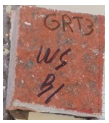 | |
2 | NMaT3 | Natural Marble Type 3 white color for walls | 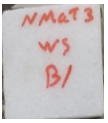 | MaT3 | Natural Marble Type 3 white color for walls | 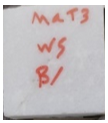 |
3 | NST1 | Natural Stone Type 1 for walls | 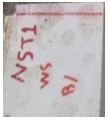 | ST1 | Natural Stone Type 1 for walls | 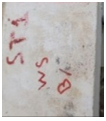 |
4 | NWPai+GT1 | Water-Based Paint with Gypsum Type 1 beige color for walls |  | WPai+GT1 | Water-Based Paint with Gypsum Type 1 beige color for walls |  |
Al-Shaheed Qahtan Ali Al-Lami School | ||||||
(ES) Samples Exposed to Environmental Conditions Only | (EHS) Samples Exposed to Environmental and Human Conditions | |||||
Sample Code | Item Description | Sample Image | Sample Code | Item Description | Sample Image | |
1 | NMaT1 | Natural Marble Type 1 green color for walls | MaT1 | Natural Marble Type 1 green color for walls | ||
2 | NST1 | Natural Stone Type 1 for walls | ST1 | Natural Stone Type 1 for walls | ||
3 | NCT1 | Ceramic Type 1 beige color for flooring | CT1 | Ceramic Type 1 beige color for flooring | ||
4 | NACT1 | Aluminum Composite Panel Type 1 white color for walls | ACT1 | Aluminum Composite Panel Type 1 white color for walls | ||
The building consists of eighteen (18) classrooms distributed across three floors, as illustrated in Figure 10, and accommodates approximately 380 students. It was constructed in 2000 and underwent its most recent renovation in 2017. Located in the Al-Zahra neighborhood of Basra, Iraq (Figure 11), the school is situated amidst busy main streets and unregulated commercial shops, contributing to a visually chaotic environment.








The facade features a combination of finishing materials, including natural stone (Stone Type One – ST1), green marble (Marble Type One – MAT1), aluminum composite panels (Aluminum Composite Panel Type One – ACT1), and ceramic tiles (Ceramic Type One – CT1), as presented in Table 7. On-site inspection (Figures 12-17) reveals a moderate level of deterioration in these materials. This condition is influenced by factors such as the relatively small student population, consistent maintenance efforts, and noticeable wear in high-traffic areas, particularly gathering spaces and restrooms. Additionally, the ease of material disassembly—resulting from substandard execution—has contributed to the overall decline in the technical condition of the building's finishing components.
This section will show samples of the finished materials from the two schools that were subjected to laboratory simulation tests, and these will be presented in Table 7 with photographs and descriptions accompanying each finishing material. The samples were taken from sites exposed only to environmental conditions (ES) where the letter (N) in the sample code represents non-use by humans, for example sample (NGRT3), and from sites exposed to both environmental and human conditions (EHS). The results were calculated based on the average values of the two samples for the same material.
5. Results and Discussion
The analysis form was developed with indicators to verify the variables based on the information derived from the selected samples for the practical study, which was obtained through field surveys of the samples and laboratory simulations and tests of the finishing material samples in the selected schools, as illustrated in Table 8.
Main Vocabulary | Secondary Vocabulary | Indicators | Asmaa Bent Abi Bakr School | Al-Shaheed Qahtan Ali Al-Lami School | Ratio Average | ||||
Material durability A | 34.14% | Material Resistance AA | 30.97% | Impact Resistance AAA | 8.78% | 15.67% | 12.23% | ||
Stain Resistance AAB | 25.00% | 23.00% | 24.00% | ||||||
Cleaning Agent Resistance AAC | 3.75% | 9.66% | 6.71% | ||||||
Corrosion Resistance AAD | 13.57% | 22.51% | 18.04% | ||||||
Friction Resistance AAE | 29.52% | 34.66% | 32.09% | ||||||
Dimensional Stability AAF | 50.49% | Heat Resistance AAFA | 55.50% | 67.48% | 61.49% | ||||
Moisture Resistance AAFB | 35.55% | 43.41% | 39.48% | ||||||
Material Hardness AB | 53.21% | 34.25% | 43.73% | ||||||
Material Density AC | 4.05% | 4.56% | 4.30% | ||||||
Adhesion Capability AD | 42.01% | 40.43% | 41.22% | ||||||
Material Condition B | 29.82% | Maintenance Needs BA | 24.54% | Minor damage BAA | 29.13% | 32.01% | 30.57% | ||
Great damage BAB | 40.63% | 24.59% | 32.61% | ||||||
Critical condition BAC | 15.37% | 5.51% | 10.44% | ||||||
Material Degradation BB | 52.49% | Extent of Degradation BBA | 73.62% | Wall Collapse Rate BBAA | 85.13% | 62.11% | 73.62% | ||
Frequency of | 50.00% | Number Of Degradation Occurrences BBBA | 66.67% | 33.33% | 50.00% | ||||
Speed Of Degradation BBBB | 32.00% | 68.00% | 50.00% | ||||||
Type of Degradation BBC | 40.63% | 32.01% | 36.32% | ||||||
Previous Maintenance Impact BC | 13.75% | 11.14% | 12.44% | ||||||
The testing was conducted according to the British Standard [32]. The impact resistance was calculated using the following equations: e = v / u.
where:
v represents the velocity of impact (falling speed).
U represents the velocity of rebound (rebound speed).
The velocity of impact v is calculated using the following equation: v = √(2gh₂).
where:
h2 represents the rebound height in centimeters.
g represents the acceleration due to gravity (= 981 cm/s²).
The value of (u) is calculated using the equation: u = √(2gh₂).
where:
h1 represents the drop height in centimeters.
For the test, a Coefficient of Restitution (e) measuring device was utilized, which was constructed by the researchers to closely replicate the device described in the relevant British Standard, as illustrated in Figures 18 and 19. Average values were calculated, and the results were obtained by comparing the samples. The coefficient of restitution (e) was measured for various materials across two schools, with the findings presented in Table 9.
The highest rebound ratio recorded at Asmaa Bent Abi Bakr School was for NST1, at 15.48%, while at Al-Shaheed Qahtan Ali Al-Lami School, the highest was for NCT1, at 21.16%. The overall average rebound ratios were 8.78% for Asmaa Bent Abi Bakr School and 15.67% for Al-Shaheed Qahtan Ali Al-Lami School.
Asmaa Bent Abi Bakr School | ||||
ES | Coefficient of Restitution (e) | EHS | Coefficient of Restitution (e) | Rebound Ratio |
NGRT3 | 87.29% | GRT3 | 82.81% | 5.13% |
NMaT3 | 71.27% | MaT3 | 75.60% | 5.72% |
NST1 | 42.17% | ST1 | 35.64% | 15.48% |
Average Ratios | 8.78% | |||
Al-Shaheed Qahtan Ali Al-Lami School | ||||
ES | Coefficient of Restitution (e) | EHS | Coefficient of Restitution (e) | Rebound Ratio |
NMaT1 | 82.81% | MaT1 | 76.43% | 7.70% |
NST1 | 42.17% | ST1 | 35.64% | 15.48% |
NCT1 | 68.55% | CT1 | 54.05% | 21.16% |
NACT1 | 35.64% | ACT1 | 43.65% | 18.35% |
Average Ratios | 15.67% | |||
